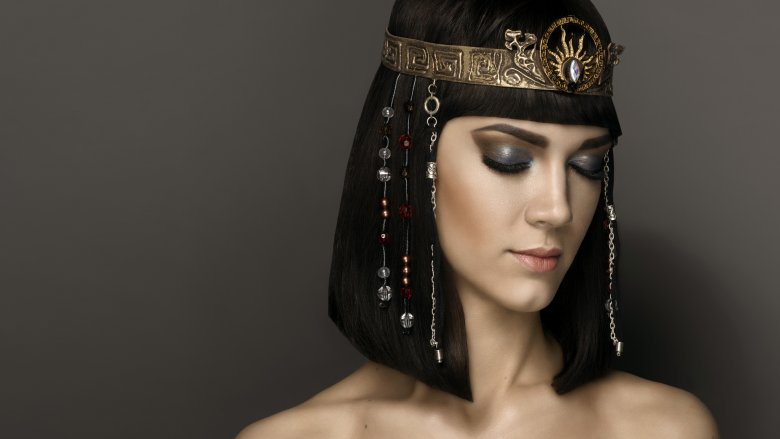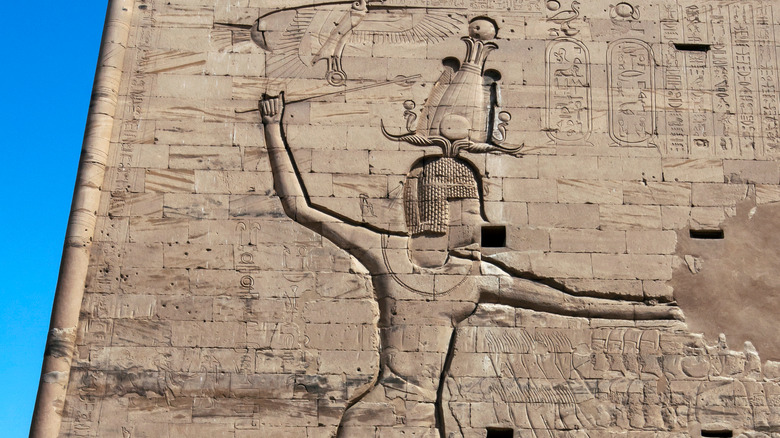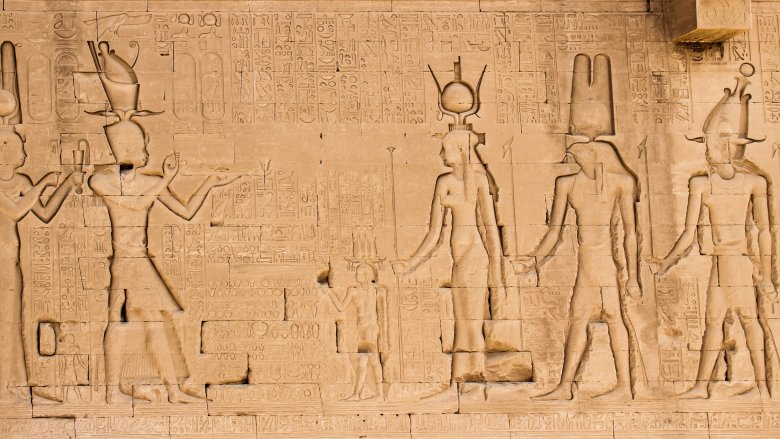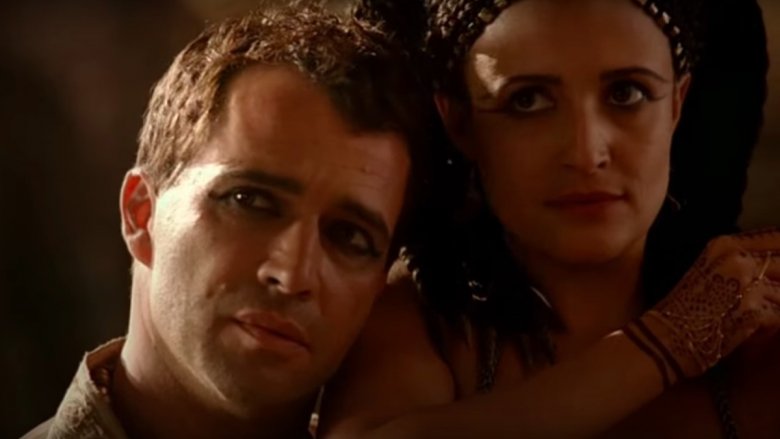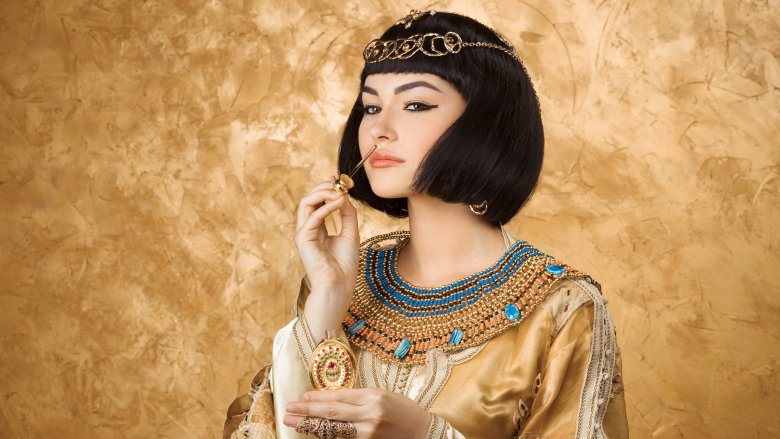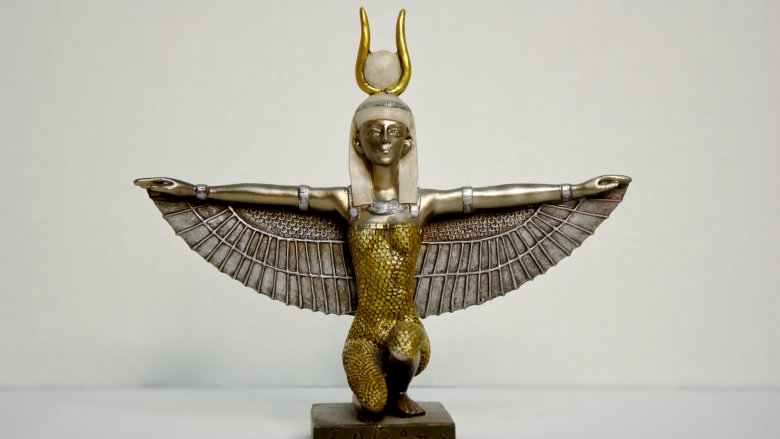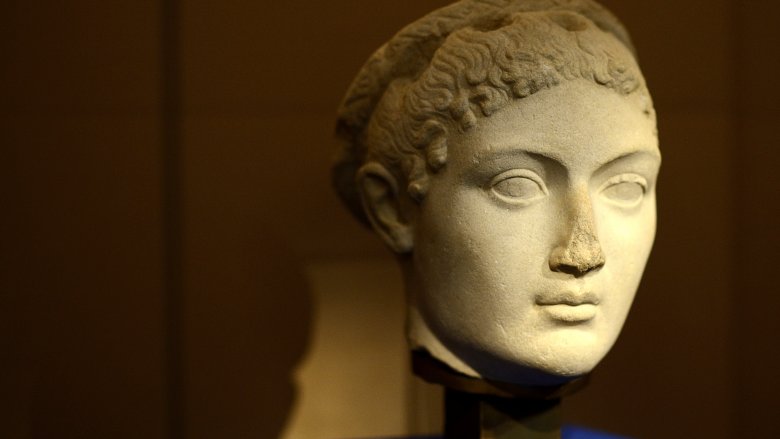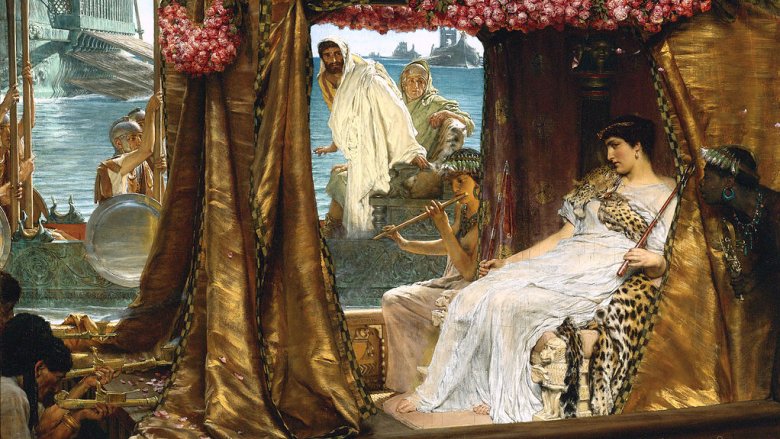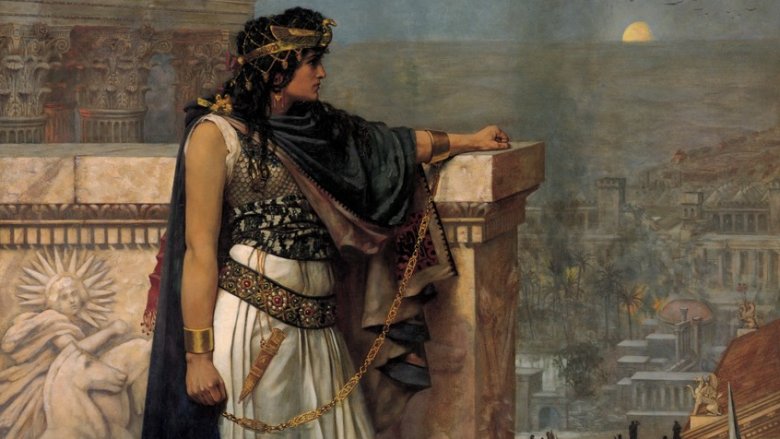Weird Things You Didn't Know About Cleopatra
She's appeared in dozens of Hollywood movies and at least a bazillion books, from biographies to historical novels to science fiction. (Yes, Cleopatra in Space is totally a thing.) Always beautiful, always exotic, always with a bunch of beads in her hair and black eyeliner that makes her look sort of like Captain Jack Sparrow, Cleopatra has attained a kind of immortality that few of her contemporaries ever did — except maybe for Julius Caesar, who attained an especially weird sort of immortality now that he shares a name with an obstetric surgery.
More than 1,500 years before the reign of Elizabeth I of England, Cleopatra proved that women were capable of ruling nations, and that they could do it with intelligence, grace, and sometimes brutality. But much of what we know — and don't know — about the queen of the Nile comes from history that has been fictionalized, refictionalized, and fictionalized some more, so much that the made-up stuff is sometimes better-known than the facts, and the facts themselves are kind of surprising.
Cleopatra wasn't Egyptian
If someone asked you to name an Egyptian from ancient history, it would probably be a toss-up between King Tut and Cleopatra. For many people, these are the two historical figures that embody ancient Egypt — gilded, eye-linered, and walking around their luxurious palaces with their hands at 90-degree angles like in that Bangles song from the '80s. But here's a funny thing: One of those two people was not actually Egyptian.
According to History of Macedonia, Cleopatra was a member of the Ptolemaic Dynasty, which was descended from Alexander the Great's general, a man named Ptolemy I. That means they not only had Greek ancestry, they spoke Greek and followed Greek customs, too. The Ptolemys ruled Egypt for 300 years after the nation was handed over to Ptolemy I following Alexander's death in 323 B.C.
So how did Egypt wind up in the hands of a bunch of helmet-wearing dudes from another continent? They conquered it, which was what the ancient Greeks often did when they were bored. The good news is the Egyptians were mostly cool with their non-Egyptian pharaoh because they were fed up with the Persians, who were the conquerors that came before the Alexandrian conquerors. (You know your country is kind of messed up when you're happy because the new conquerors are better than the old ones.)
There was some creepy Deliverance stuff in Cleopatra's background
Incest, as it turns out, is not just for nasty Lannister Queens and Deliverance characters. It was practiced to some degree in pretty much every royal family from Europe to the Middle East, but the Egyptians practically turned it into a competitive sport.
In Egyptian mythology, the god Osiris married his sister Isis in order to maintain the purity of the royal bloodline. They were gods, so presumably genetic disorders weren't really a problem for them. Unfortunately for the Egyptian pharaohs, who saw the Egyptian gods as awesome role models, genetic disorders are a problem for mortals, but no one really understood that thousands of years ago.
Anyway when the Ptolemys rose to power they were all, "Hey, incest sounds like a great idea!" So by the time that got down to Cleopatra a few hundred years later, she was a genetic soup of Ptolemys who married Ptolemys who were descended from Ptolemys.
Cleopatra's father was King Ptolemy XII. Not much is known about her mother, but Biography says it was probably her father's sister, or possibly her father's uncle's cousin's mother's sister's niece. In keeping with their very gross noble family tradition, Cleopatra went on to marry not one but both of her younger brothers. Eww.
Cleopatra was smarter than she was beautiful
Pretty much every modern and semi-modern depiction of Cleopatra tells us she was stunningly beautiful, which frankly does seem sort of incompatible with the whole generations of incest thing, but maybe it was a fluke. Then in February 2007 a coin was unearthed bearing a portrait of Cleopatra, which appears to confirm that the queen was actually rather ordinary-looking. The fact that ancient historians didn't say much about her looks also suggests she was no Elizabeth Taylor, but the more important point is that it really doesn't matter. Life of Antony, written by Plutarch in 75 A.D., made the following observation about Cleopatra: "Her actual beauty ... was not so remarkable that none could be compared with her, or that no one could see her without being struck by it, but the contact of her presence ... was irresistible. ... The character that attended all she said or did was something bewitching."
According to Ancient Origins, Cleopatra wasn't just a shrewd diplomat, she was also a student of mathematics, medicine, alchemy, economics, history, geography, and pretty much every general education subject you probably detested in college (except maybe alchemy, which they mostly don't teach anymore). She also spoke nine languages, beating anyone who's ever run the White House. (The last multilingual president was Franklin Roosevelt, who was elected in 1932 and spoke French and German.)
Cleopatra could actually speak the same language as the people she ruled
Besides Greek, which was the native tongue of the Ptolemaic dynasty, Cleopatra spoke the languages of most neighboring people, including the Arabs, Jews, Parthians, Syrians, Ethiopians, Medes, and the Trogodytae. She was also the only member of the Ptolemaic dynasty who bothered to learn the language of Egypt — until her reign the Ptolemys didn't show any interest in Egyptian culture or religion and mostly just sequestered themselves in the city of Alexandria, which was sort of like the Chinatown of Ancient Egypt, except Greeker. The Greek language became Egypt's language of commerce and government, and the Ptolemys occasionally reminded themselves they were in Egypt by taking a pleasure cruise down the Nile, but that was about it.
According to Ancient Origins, Cleopatra could speak the native Coptic and she could also read hieroglyphics. What's more, she had herself depicted as an Egyptian, wearing the traditional dress, and attending traditional Egyptian festivals and ceremonies. She was such a PR pro, in fact, that she was proclaimed a patriot and became a popular leader among the Egyptian people even though she wasn't descended from any true Egyptian pharaohs. Cleopatra, unlike her predecessors, recognized the value of appealing to the cultural identity of the people she ruled, which is quite an evolved idea even for a lot of modern politicians.
Cleopatra killed three of her siblings, including the two she was married to
Now let's get back to the whole incest thing, since you can never have too much of that. In Egypt it was customary for pharaohs to rule in pairs — every regent needed a co-regent of the opposite gender. According to LiveScience, Cleopatra ruled with her father Ptolemy XII for a short time until his death in 51 B.C. In his will, Ptolemy XII decreed that Cleopatra should marry her 11-year-old brother, which was probably only a ceremonial thing, but either way the two were clearly not fond of each other and the relationship ended with Ptolemy XIII trying to wrest control of the throne, and his sister appealing to Julius Caesar for help reining him in.
Caesar and Cleopatra famously became lovers, and Ptolemy XIII was never happy with Caesar's decision that he should rule with his sister. Eventually, Caesar defeated Ptolemy at the Battle of the Nile, and Ptolemy drowned in the river while trying to escape. So Cleopatra was really only partially responsible for that brother's death, but there's more.
Because of the whole "must have a co-regent thing," Cleopatra had to marry her other brother, who later died under "mysterious circumstances." (Cleopatra had him poisoned.) Then she ordered the execution of her sister Arsinoe, who took Ptolemy's side during the family feud and at one point declared herself queen. We can add fratricide to Cleopatra's list of virtues, but who's counting?
Cleopatra's famous eye makeup was actually supposed to ward off eye infections
There's hardly a depiction of Cleopatra that doesn't include the trademark eye makeup — a black kohl that lined the eyes and sometimes continued down the side of the face to form decorative spirals. According to the New York Times, the kohl was made from four different lead-based materials and was actually meant not as a beauty enhancer but to ward off eye infections. Eye infections were common in Ancient Egypt because when the Nile flooded, it would stir all kinds of marshy gunk into the water, which could then get in people's eyes and cause inflammation. The lead-based makeup was toxic to the bacteria that caused those infections, so it did have a preventative effect, though that probably didn't balance out very well with the whole lead poisoning thing.
Cleopatra was pretty shrewd, so she might have understood the medicinal properties of the kohl, but most Egyptians thought it was magic. Either way, it seems pretty scary to line your eyes with lead-based metals, but ancient Egyptians also liked to pull the brains out of dead bodies with an iron hook and put their guts in jars, so on a scale of 1 to weird, lead-based eye makeup doesn't even register.
Cleopatra and Mark Antony had their own drinking club
Cleopatra was smart, shrewd, capable, and also kind of a party animal. But you probably would be too, if you had absolute power and Roman general Mark Antony was your boyfriend.
As it turns out, Cleopatra and Antony (who was Cleopatra's lover after the death of Caesar and after the "totally accidental" deaths of her two brother-husbands) weren't so preoccupied by matters of state that they made no time for fun, just as college fraternities are never so preoccupied by midterms that they make no time for keg parties and passing out in puddles of their own vomit. Cleopatra and Antony even formed their own drinking club, which they named "Inimitable Livers." The English translation of the name could mean a couple of things, with "livers" either referring to actual life or your internal organs. (Probably the first one, but the second one is more fun.)
Anyway, according to Food and Wine (and they would know), Inimitable Livers was officially dedicated to Dionysus, the god of wine. Unofficially, it was an excuse to have keg parties and pass out in puddles vomit. The club threw nightly "feasts and wine-binges," and then afterward Antony and Cleopatra would wander around the city in a state of drunken giddiness and play pranks on common Alexandrians. For shame. Modern politicians would never, ever behave like that.
Cleopatra owned a perfume factory
We've already established that Cleopatra was interested in alchemy, but she also understood a bit of actual chemistry. She believed in the power of fragrance not just as a cosmetic but also as a tool of persuasion. According to Perfume Power, Cleopatra doused her ship's sails with perfume before sailing to her first rendezvous with Mark Antony to make sure that he smelled her before he saw her. She also owned a perfume factory, which sort of seems like an odd side job for a queen, but if you just can't find the sort of mind-control fragrances you need at the Macy's perfume counter, there's probably some value in just having it done at your own factory.
The ruins of Cleopatra's perfume factory are by the Dead Sea near Ein Gedi, and there is evidence that it also operated as a sort of day spa — some seating remains, which is reminiscent of the chairs you might sit in to have your nails done or if you, too, wanted to be doused with mind-control fragrances. Cleopatra even had her perfume recipes recorded in a book called Gynaeciarum Libri, which has unfortunately been lost, perhaps perishing in the fire at the Library of Alexandria.
Cleopatra once spent the modern equivalent of $20 million on a cocktail
It's kind of obnoxious when the uber-rich sail past impoverished fishing villages in their $100 million yachts, but at least no one has ever sunk one on purpose just because they can. (Let's hope.) Cleopatra, on the other hand, was not at all fussed about throwing her money away (or more accurately, dissolving it) to prove a point.
According to legend, Cleopatra once bet Mark Antony that she could blow 10 million sesterces on a single meal — that's somewhere around $10 million to $20 million in today's money. She then requested a modest meal, and afterward had her servants bring her a cup of vinegar. Then, according to NBC, she took off one of her earrings, removed the pearl, dropped it in the vinegar, and watched it dissolve. Then she drank the cup of vinegar, thus proving that she would do just about anything to win a bet.
Pliny the Elder said the pearl was "the largest in the whole of history," and a "remarkable and truly unique work of nature," but who knows how much they paid him to write that. Modern historians were more skeptical of the science until someone finally tested the theory with actual vinegar and an actual pearl. The test confirmed that vinegar does, in fact, dissolve the calcium carbonate in a pearl, but it would have likely taken longer than a day for the entire pearl to disappear. But still plausible, in a sinking-your-own-yacht kind of a way.
Cleopatra convinced Egypt she was the reincarnation of the goddess Isis
Most ancient rulers saw themselves as divine, even godlike. Some of today's rulers do, too, so we shouldn't judge too harshly. For Cleopatra, the whole ruler-as-divine thing was part ego, part public relations genius.
According to scholar Elizabeth A. McCabe, Cleopatra called herself "the new Isis," telling her subjects she was the embodiment of Isis on Earth, or the reincarnation of the goddess. Not to be left out, Mark Antony also claimed to be the embodiment of Osiris on Earth. Remember the whole Isis marries her brother Osiris thing? There you go.
Now, that's not to say that Cleopatra was very dedicated to the whole Isis thing. Prior to that she was known to play whichever goddess happened to suit her. When she sailed to that first meeting with Mark Antony on her perfumed barge, she was dressed as the goddess Venus and was waited on by young boys dressed as Cupids and maids dressed as sea nymphs. Antony was enamored, but those were different times. Imagine if the person you met on Match.com showed up for your first date on a perfumed barge dressed as a Greek deity. You'd probably hastily finish your cocktail and sneak out the bathroom window.
Cleopatra might not have died from a snake bite
One of Cleopatra's most enduring legends has to do not with her life but with her death. According to the story, when Cleopatra learned her forces had been defeated by Octavian, who would become the first emperor of Rome, she calmly wrote a suicide note, handed it over to a guard, and then killed herself by holding a venomous snake to her breast.
Because historians like to debate things, no one really definitively accepts this account of Cleopatra's death. Sure, it's kind of a cool way to go, but there are some problems with it. For a start, the story indicates that it only took a few minutes for her to die, but the venom of that particular kind of Egyptian snake actually takes a few hours to work, and is even occasionally survivable.
According to the Smithsonian, most historians do agree Cleopatra's death was a suicide, but the method isn't clear. It's possible she simply drank a vial of poison, but that story just isn't as dramatic, which is probably why today most people still think it was a snake.
Cleopatra was the last Egyptian pharaoh
The whole fratricide thing excluded, Cleopatra had mostly good intentions for the nation she ruled. According to ThoughtCo, she wanted Egypt to remain an independent state, and most of what she did (except maybe the drinking club and the thing with the pearl) was to that end. Unfortunately her dreams of a free Egypt died with her — after her suicide in the summer of 30 B.C., Octavian seized control of Egypt and made it a province of Rome, ending the era of the Egyptian pharaohs.
It was a while before Cleopatra was remembered fondly by anyone but her own people — the Romans undertook what could only be called a smear campaign, painting her as a harlot who seduced her way to power and practiced witchcraft to bring powerful men under her control. Even a couple hundred years later, poets were remembering her as "the shame of Egypt" and "the bane of Rome," which probably suited the male-dominated Roman leadership just fine.
Try not to feel too bad for her, though. Cleopatra reigned for more than 20 years and had great success as a leader, enjoyed a life of luxury, and died on her own terms. Plus, she had that whole drinking club thing to help her pass the time. Things could have been a lot worse.
How many donkeys does it take to fill an Egyptian queen's bathtub?
Like pretty much every human being, Cleopatra had an innate desire to avoid getting older. Unfortunately, plastic surgeons were in short supply in first-century B.C. Egypt, and Botox wouldn't be invented for another couple millennia. But it's good to be the queen because the queen can pursue ridiculously elaborate beauty regimes that aren't available to the average person. In fact, Cleopatra's favorite spa treatment was something most modern American billionaires would have a hard time pulling off even one time, never mind every morning.
According to legend, Cleopatra's daily bath required a tub and 700 lactating donkeys. At first this might sound kind of like something the queen made up to keep her servants busy, but bathing in donkey milk was actually not just some crazy Cleopatraism. According to The Vintage News, all over the ancient world, women used donkey milk to keep their skin pale and to keep wrinkles at bay. Emperor Nero's wife was said to travel with "whole troops of she-asses" so she'd never have to miss her daily donkey-milk bath. And today, scientists know donkey milk has a lot of important health benefits — it can be used as a cow milk substitute for people with allergies, and yes, it's also used in modern beauty products, just in case you don't think you'll be able to procure yourself 700 donkeys and enough servants to milk them every day.
I know I erected a gilded statue in Cleopatra's honor, but I swear she meant nothing to me
Throughout much of ancient history, women had to endure their cheating husbands because divorce wasn't usually an option and you couldn't exactly put a tracking device under his horse or anything. Mostly, you were just expected to smile happily and pretend like you weren't feeling totally humiliated. So imagine what Julius Caesar's wife Calpurnia must have thought when her husband erected a gilded statue of Cleopatra in the temple of Venus Genetrix, right next to the statue of the goddess herself.
This was obnoxious on a number of levels, not just because Caesar seemed completely indifferent to how a very public statue of his mistress would make his wife feel, but also because the Romans didn't believe their rulers were particularly divine the way the Egyptians did. So having a statue of an Egyptian queen in a holy temple was pretty impious, especially coming from the dude who was supposed to be the country's religious leader.
However scandalized the Roman people were by the statue of Cleopatra, historian Antony Kamm notes in Julius Caesar: A Life that Cleopatra's statue remained in the temple for at least 200 years, even after the queen was declared an enemy of Rome. So it's possible the statue had at least some religious significance, probably because of Cleopatra's association with the goddess Isis, who had her own minor cult following in Rome.
I know I blew off an invasion for Cleopatra, but I swear she meant nothing to me
It's no great revelation that love makes you do irrational things, but most people won't blow off an important meeting or deadline so they can hang out with someone they only just met. Mark Antony was not most people. He skipped an entire invasion so he could spend the winter with Cleopatra in her Alexandrian palace.
According to HistoryNet, in 41 B.C. Antony assembled an army and went east, summoning client-kings in hopes of gathering resources for a Parthian invasion. One of those client-kings was 28-year-old Cleopatra, who said something to the effect of, "Let's make love, not war." Then Antony said something to the effect of, "The invasion can wait" and followed her back to Alexandria, leaving his army in the hands of his governor.
While Antony was enjoying the excesses of the Egyptian palace, the Parthians crossed the Euphrates River, attacked Syria, and annexed many of Antony's troops. Meanwhile, Antony's wife Fulvia had to flee Rome after getting her butt kicked by Julius Caesar's heir Octavian. It's hard to say which is worse, being attacked by your husband's political rival while he's off cheating on you with his Egyptian queen mistress, or keeping your mouth shut while your husband erects a gilded statue of his Egyptian queen mistress. If Fulvia and Calpurnia had formed a scorned wives club, Roman history could have been a great CW series.
If you can't beat 'em, die together and have yourselves buried in a secret tomb
Cleopatra and Antony may or may not have died together, but someone made sure they were buried together — at least that's what Plutarch tells us. Beyond that, we have no idea. Some historians think they were buried in Alexandria, most of which fell into the sea after an earthquake 1,600 years ago. According to Remezcla, a few archaeologists think they're buried beneath the Taposiris Magna Temple (one of the many supposed resting places of the disembodied god Osiris) about 30 miles west of Alexandria. Cleopatra considered herself and her lover to be living embodiments of Isis and Osiris, so a temple burial does seem possible. If the pair was indeed buried beneath the temple, it would have been an effective strategy to keep their bodies out of the hands of the Romans, as well as an appropriate resting place for a couple of formerly-living god/goddess embodiments.
Archaeologist Kathleen Martinez found four burial chambers and more than 600 artifacts at Taposiris Magna, many of which bear the likenesses of Cleopatra and Mark Antony. But so far, the tomb itself remains undiscovered. Cleopatra probably would have been mummified since she was known to have followed Egyptian customs and practices. But Plutarch writes that Mark Antony was cremated in the Roman custom, so if archaeologists do discover their tomb, it's unclear what state the two might actually be in.
23 and Cleo
23 and Me might be able to tell you about your Greek heritage, but without a body it will never be able to find the descendants of Cleopatra and Mark Antony. According to Ancient Origins, at least one of their children survived to adulthood and went on to have children of her own — Cleopatra Selene, who married King Juba of Mauretania. The couple had a boy and a girl, but only the boy's name was remembered. Called "Ptolemy" after all the kajillions of Ptolemys who came before him, the unfortunate young man was murdered by the emperor Caligula, evidently because he looked too awesome in a purple robe.
Whether Ptolemy had any children is not certain, and without more evidence it's also impossible to know if his unnamed sister had children. The list of possible descendants is a convoluted line of so-and-so might have begat so-and-so, finally filtering down to one person who loudly proclaimed descent from Cleopatra: the Syrian queen Zenobia, who conquered Egypt 200 years after Cleopatra's death. But it's just as likely that Zenobia's claim was pure propaganda — she was a conqueror and was probably looking for a way to strengthen her claim. Either way, it's kind of fun to imagine that out there somewhere there might be a bona fide but oblivious Cleopatra descendant living in a college dorm and working at The Old Spaghetti Factory. But we'll probably never know for sure.
